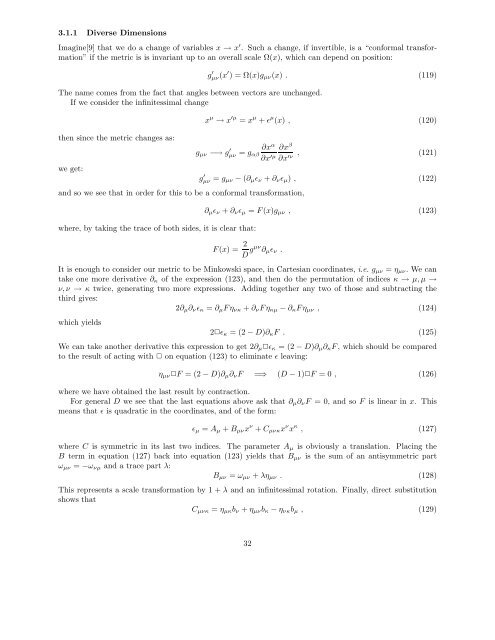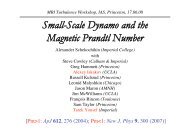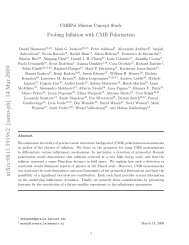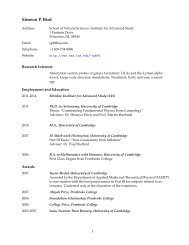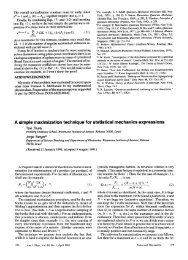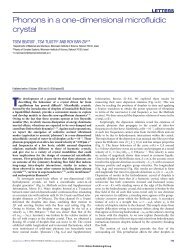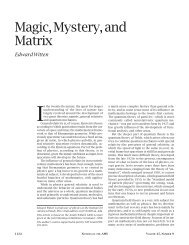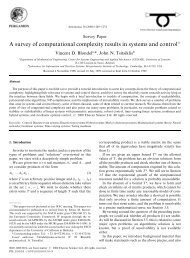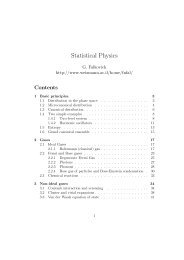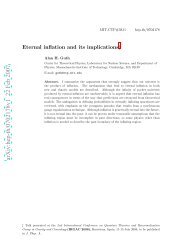Introduction to String Theory and D–Branes - School of Natural ...
Introduction to String Theory and D–Branes - School of Natural ...
Introduction to String Theory and D–Branes - School of Natural ...
You also want an ePaper? Increase the reach of your titles
YUMPU automatically turns print PDFs into web optimized ePapers that Google loves.
3.1.1 Diverse Dimensions<br />
Imagine[9] that we do a change <strong>of</strong> variables x → x ′ . Such a change, if invertible, is a “conformal transformation”<br />
if the metric is is invariant up <strong>to</strong> an overall scale Ω(x), which can depend on position:<br />
g ′ µν(x ′ ) = Ω(x)gµν(x) . (119)<br />
The name comes from the fact that angles between vec<strong>to</strong>rs are unchanged.<br />
If we consider the infinitessimal change<br />
then since the metric changes as:<br />
we get:<br />
x µ → x ′µ = x µ + ɛ µ (x) , (120)<br />
gµν −→ g ′ µν<br />
∂x<br />
= gαβ<br />
α<br />
∂x ′µ<br />
<strong>and</strong> so we see that in order for this <strong>to</strong> be a conformal transformation,<br />
where, by taking the trace <strong>of</strong> both sides, it is clear that:<br />
∂xβ , (121)<br />
∂x ′ν<br />
g ′ µν = gµν − (∂µɛν + ∂νɛµ) , (122)<br />
∂µɛν + ∂νɛµ = F(x)gµν , (123)<br />
F(x) = 2<br />
D gµν ∂µɛν .<br />
It is enough <strong>to</strong> consider our metric <strong>to</strong> be Minkowski space, in Cartesian coordinates, i.e. gµν = ηµν. We can<br />
take one more derivative ∂κ <strong>of</strong> the expression (123), <strong>and</strong> then do the permutation <strong>of</strong> indices κ → µ, µ →<br />
ν, ν → κ twice, generating two more expressions. Adding <strong>to</strong>gether any two <strong>of</strong> those <strong>and</strong> subtracting the<br />
third gives:<br />
2∂µ∂νɛκ = ∂µFηνκ + ∂νFηκµ − ∂κFηµν , (124)<br />
which yields<br />
2✷ɛκ = (2 − D)∂κF . (125)<br />
We can take another derivative this expression <strong>to</strong> get 2∂µ✷ɛκ = (2 − D)∂µ∂κF, which should be compared<br />
<strong>to</strong> the result <strong>of</strong> acting with ✷ on equation (123) <strong>to</strong> eliminate ɛ leaving:<br />
ηµν✷F = (2 − D)∂µ∂νF =⇒ (D − 1)✷F = 0 , (126)<br />
where we have obtained the last result by contraction.<br />
For general D we see that the last equations above ask that ∂µ∂νF = 0, <strong>and</strong> so F is linear in x. This<br />
means that ɛ is quadratic in the coordinates, <strong>and</strong> <strong>of</strong> the form:<br />
ɛµ = Aµ + Bµνx ν + Cµνκx ν x κ , (127)<br />
where C is symmetric in its last two indices. The parameter Aµ is obviously a translation. Placing the<br />
B term in equation (127) back in<strong>to</strong> equation (123) yields that Bµν is the sum <strong>of</strong> an antisymmetric part<br />
ωµν = −ωνµ <strong>and</strong> a trace part λ:<br />
Bµν = ωµν + ληµν . (128)<br />
This represents a scale transformation by 1 + λ <strong>and</strong> an infinitessimal rotation. Finally, direct substitution<br />
shows that<br />
Cµνκ = ηµκbν + ηµνbκ − ηνκbµ , (129)<br />
32


